
226 CHAPTER 9. THE LEBESGUE INTEGRAL
Letting ∥h∥ ≡max{|h(x)| : x ∈ BR} , It follows from the Weierstrass approximation the-orem, there exists a function whose components are polynomials gk such that ∥gk−f k∥<
Rk+1 . Then if x ∈ BR, it follows
|gk (x)| ≤ |gk (x)−f k (x)|+ |f k (x)|<R
1+ k+
kR1+ k
= R
and so gk maps BR to BR. By Lemma 9.13.4 each of these gk has a fixed point xk such thatgk (xk) =xk. The sequence of points, {xk} is contained in the compact set, BR and so thereexists a convergent subsequence still denoted by {xk} which converges to a point x ∈ BR.Then from uniform convergence of gk to f , f (x) = limk→∞f (xk) = limk→∞gk (xk) =limk→∞xk = x. ■
The ball does not have to be centered at 0. If f : B(a,R)→ B(a,R) is continuous,then y→ f (y+a)−a maps B(0,R) to B(0,R) has a fixed point y = f (y+a)−a sof (y+a) = y+a.
Corollary 9.13.6 A continuous function mapping a closed ball having center at a toitself has a fixed point.
Definition 9.13.7 A set A is a retract of a set B if A⊆ B, and there is a continuousmap h : B→ A such that h(x) = x for all x ∈ A and h is onto. B has the fixed pointproperty means that whenever g is continuous and g : B→ B, it follows that g has a fixedpoint.
Proposition 9.13.8 Let A be a retract of B and suppose B has the fixed point property.Then so does A.
Proof: Suppose f : A→ A. Let h be the retract of B onto A. Then f ◦h : B→ B iscontinuous. Thus, it has a fixed point x ∈ B so f (h(x)) = x. However, h(x) ∈ A andf : A→ A so in fact, x ∈ A. Now h(x) = x and so f (x) = x. ■
Although we won’t use this, every convex compact subset K of Rp is a retract of all ofRp obtained by using the projection map. See Problems beginning with 8 on Page 137. Inparticular, K is a retract of a large closed ball containing K, which ball has the fixed pointproperty. Therefore, K also has the fixed point property. This shows the following which isa convenient formulation of the Brouwer fixed point theorem. However, Proposition 9.13.8is more general. You can likely imagine sets which are retracts which might not be convex.
Theorem 9.13.9 Every convex closed and bounded subset of Rp has the fixed pointproperty.
As an application of the Brouwer fixed point theorem is the following lemma. It saysroughly that if a continuous function does not move points near p very far, then the imageof a ball centered at p contains a slightly smaller open ball.
Lemma 9.13.10 Let f be continuous and map B(p,r)⊆Rn to Rn. Suppose that for all
x ∈ B(p,r), |f (x)−x|< εr. Then it follows that f(
B(p,r))⊇ B(p,(1− ε)r)
Proof: This is from the Brouwer fixed point theorem. Consider for y ∈ B(p,(1− ε)r) ,
h(x)≡ x−f (x)+y